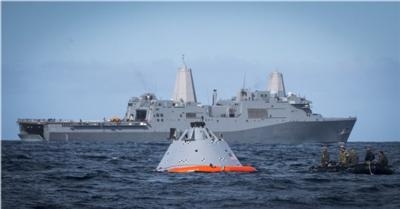Marks Second Underway Recovery Test For The Ship
Amphibious transport dock USS San Diego (LPD 22) successfully completed recovery operations of the NASA Orion crew module Nov. 1. The Underway Recovery Test-5 (URT-5) is part of a U.S. government interagency effort to safely retrieve the Orion crew module which is capable of carrying humans into deep space.

This marks the second time a URT has taken place aboard San Diego. Lessons learned from previous recovery tests and Exploration Flight Test-1 are being used to improve the recovery process and ensure the combined NASA and Navy team will be able to safely and successfully recover the Orion capsule following its flight for Exploration Mission-1 (EM-1) in 2018.
"For me it was a lot of fun being part of the testing because I was onboard this ship when we did the first URT and took the test capsule out to sea in February 2014," said San Diego Commanding Officer Capt. Carl W. Meuser. "On that trip, these smart folks from NASA were able to collect data and understand the environment much better, and they designed systems accordingly. So it's been fun for me to see the progression of NASA's project from the first time we went to sea together, to this very successful testing that we just finished."
With their main role of conducting amphibious operations, San Antonio-class ships have many unique capabilities that make them an ideal partner to support NASA. The most important capability was the ability to recover the test capsule using the ship's well deck, which was originally designed to launch and recover amphibious craft. San Diego also has the ability to carry and deploy multiple small boats which aid in the recovery process and contains an advanced medical facility for the returning astronauts.
URT-5 testing consisted of launching the test capsule from the well deck, then carefully maneuvering the ship alongside the capsule at slow speed. Then, divers attached lines from the small boats to steady and guide the capsule toward San Diego, where a NASA-designed winch hauled the capsule into the well deck.
"It's very challenging; what seems like a basic recovery is anything but," said Chief Petty Officer Beau Lontine, a Navy diver assigned to Explosive Ordnance Disposal Mobile Unit 3. "It's a very high-risk evolution, especially when the capsule is being towed behind the ship, and that's where our inputs to the equipment that they've designed for this come into play. That's what we do; we work with rigging and hardware and we do build-up and training to get to the point of recovering the capsule."
The test allowed NASA and the Navy to continue to demonstrate and evaluate the recovery processes, procedures, hardware and personnel in real, open ocean environment before conducting actual recovery operations for EM-1 and with additional coordination, subsequent exploration missions.
"This was a proof-of-concept URT, which means we were testing hypotheses that we had developed over the last year, along with some prototype hardware," said NASA's Landing and Recovery Director, Melissa Jones. "I'm happy to say that it was very successful and we have a lot of data going forward to figure out what our next test will be."
According to Jones, the next test will take place aboard another seasoned NASA recovery ship, USS Anchorage (LPD 23). Future tests will eventually get NASA and the Navy to arrive at a safe and more efficient way to recover the capsule for the 2021 mission involving a flying crew.
(Image provided with U.S. Navy news release)
 Bolen Gives Congress a Rare Thumbs-Up
Bolen Gives Congress a Rare Thumbs-Up The SportPlane Resource Guide RETURNS!!!!
The SportPlane Resource Guide RETURNS!!!! Buying Sprees Continue: Textron eAviation Takes On Amazilia Aerospace
Buying Sprees Continue: Textron eAviation Takes On Amazilia Aerospace Hawker 4000 Bizjets Gain Nav System, Data Link STC
Hawker 4000 Bizjets Gain Nav System, Data Link STC Echodyne Gets BVLOS Waiver for AiRanger Aircraft
Echodyne Gets BVLOS Waiver for AiRanger Aircraft



